by Patricia Callahan and Sam Roe
Chicago Tribune Reporters
NOTICE: THIS WORK MAY BE PROTECTED BY COPYRIGHT
YOU ARE REQUIRED TO READ THE COPYRIGHT NOTICE AT THIS LINK BEFORE YOU READ THE FOLLOWING WORK, THAT IS AVAILABLE SOLELY FOR PRIVATE STUDY, SCHOLARSHIP OR RESEARCH PURSUANT TO 17 U.S.C. SECTION 107 AND 108. IN THE EVENT THAT THE LIBRARY DETERMINES THAT UNLAWFUL COPYING OF THIS WORK HAS OCCURRED, THE LIBRARY HAS THE RIGHT TO BLOCK THE I.P. ADDRESS AT WHICH THE UNLAWFUL COPYING APPEARED TO HAVE OCCURRED. THANK YOU FOR RESPECTING THE RIGHTS OF COPYRIGHT OWNERS.

"I'm a well-meaning guy. I'm not in the pocket of industry." — Dr. David Heimbach, a burn expert. Above, Heimbach testifies in 2011 against a California state Senate bill that could have reduced the use of flame retardant chemicals in furniture. Citizens for Fire Safety has paid for his travel to testify and for some of his time, he said later. (Robert Durell, For the Tribune)
Dr. David Heimbach knows how to tell a story.
Before California lawmakers last year, the noted burn surgeon drew gasps from the crowd as he described a 7-week-old baby girl who was burned in a fire started by a candle while she lay on a pillow that lacked flame retardant chemicals.
"Now this is a tiny little person, no bigger than my Italian greyhound at home," said Heimbach, gesturing to approximate the baby's size. "Half of her body was severely burned. She ultimately died after about three weeks of pain and misery in the hospital."
Heimbach's passionate testimony about the baby's death made the long-term health concerns about flame retardants voiced by doctors, environmentalists and even firefighters sound abstract and petty.
But there was a problem with his testimony: It wasn't true.
Records show there was no dangerous pillow or candle fire. The baby he described didn't exist.
Neither did the 9-week-old patient who Heimbach told California legislators died in a candle fire in 2009. Nor did the 6-week-old patient who he told Alaska lawmakers was fatally burned in her crib in 2010.
Heimbach is not just a prominent burn doctor. He is a star witness for the manufacturers of flame retardants.
His testimony, the Tribune found, is part of a decades-long campaign of deception that has loaded the furniture and electronics in American homes with pounds of toxic chemicals linked to cancer, neurological deficits, developmental problems and impaired fertility.
The tactics started with Big Tobacco, which wanted to shift focus away from cigarettes as the cause of fire deaths, and continued as chemical companies worked to preserve a lucrative market for their products, according to a Tribune review of thousands of government, scientific and internal industry documents.
These powerful industries distorted science in ways that overstated the benefits of the chemicals, created a phony consumer watchdog group that stoked the public's fear of fire and helped organize and steer an association of top fire officials that spent more than a decade campaigning for their cause.
Today, scientists know that some flame retardants escape from household products and settle in dust. That's why toddlers, who play on the floor and put things in their mouths, generally have far higher levels of these chemicals in their bodies than their parents.
Blood levels of certain widely used flame retardants doubled in adults every two to five years between 1970 and 2004. More recent studies show levels haven't declined in the U.S. even though some of the chemicals have been pulled from the market. A typical American baby is born with the highest recorded concentrations of flame retardants among infants in the world.
People might be willing to accept the health risks if the flame retardants packed into sofas and easy chairs worked as promised. But they don't.
The chemical industry often points to a government study from the 1980s as proof that flame retardants save lives. But the study's lead author, Vytenis Babrauskas, said in an interview that the industry has grossly distorted his findings and that the amount of retardants used in household furniture doesn't work.
"The fire just laughs at it," he said.
Other government scientists subsequently found that the flame retardants in household furniture don't protect consumers from fire in any meaningful way.
The U.S. Environmental Protection Agency, meanwhile, has allowed generation after generation of flame retardants onto the market and into American homes without thoroughly assessing the health risks. The EPA even promoted one chemical mixture as a safe, eco-friendly flame retardant despite grave concerns from its own scientists about potential hazards to humans and wildlife.
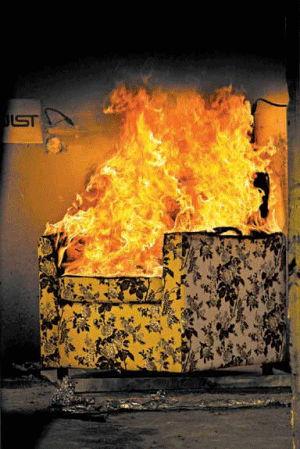
Consumer Product Safety Commission photo Up in flames: Government scientists found that chairs containing flame retardants, like the one being tested above, burned just as fast as identical chairs without them.
Since the 1970s manufacturers have repeatedly withdrawn flame retardants amid health concerns. Some have been banned by a United Nations treaty that seeks to eliminate the worst chemicals in the world.
Chemtura Corp. and Albemarle Corp., the two biggest U.S. manufacturers of flame retardants, say their products are safe and effective, arguing that they have been extensively evaluated by government agencies here and in Europe.
"Flame retardants provide an essential tool to enable manufacturers of products to meet the fire safety codes and standards necessary to protect life and property in a modern world," John Gustavsen, a Chemtura spokesman, said in a written statement.
His company, Gustavsen said, strongly disagrees with the main findings of the Tribune's investigation.
Heimbach, the burn doctor, has regularly supported the industry's position that flame retardants save lives. But he now acknowledges the stories he told lawmakers about victims were not always factual.
He told the Tribune his testimony in California was "an anecdotal story rather than anything which I would say was absolutely true under oath, because I wasn't under oath."
Heimbach, a retired Seattle doctor and former president of the American Burn Association, also said his anecdotes were not about different children but about the same infant. But records and interviews show that the baby Heimbach said he had in mind when testifying didn't die as he described and that flame retardants were not a factor.
After the Tribune confronted chemical executives with Heimbach's questionable testimony, he offered, through his lawyer, another explanation for why his stories didn't add up: He intentionally changed the facts to protect patient privacy.
Yet the most crucial parts of his testimony — the cause of the fire and the lack of flame retardants — had nothing to do with privacy. Instead, they served to bolster the industry's argument that chemical retardants save lives.
In the last quarter-century, worldwide demand for flame retardants has skyrocketed to 3.4 billion pounds in 2009 from 526 million pounds in 1983, according to market research from The Freedonia Group, which projects demand will reach 4.4 billion pounds by 2014.
As evidence of the health risks associated with these chemicals piled up, the industry mounted a misleading campaign to fuel demand.
There is no better example of these deceptive tactics than the Citizens for Fire Safety Institute, the industry front group that sponsored Heimbach and his vivid testimony about burned babies.
FEAR AND DECEPTION
In the website photo, five grinning children stand in front of a red brick fire station that could be on any corner in America. They hold a hand-drawn banner that says "fire safety" with a heart dotting the letter "i."
Citizens for Fire Safety describes itself as a group of people with altruistic intentions: "a coalition of fire professionals, educators, community activists, burn centers, doctors, fire departments and industry leaders, united to ensure that our country is protected by the highest standards of fire safety."
Heimbach summoned that image when he told lawmakers that the organization was "made up of many people like me who have no particular interest in the chemical companies: numerous fire departments, numerous firefighters and many, many burn docs."
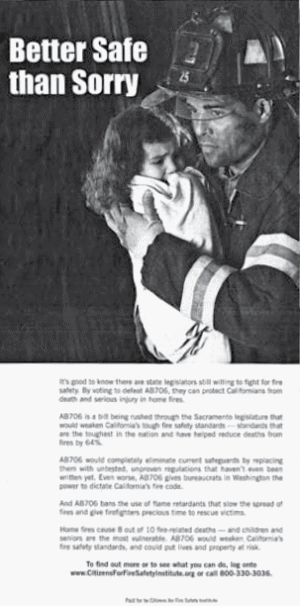
This 2008 ad in the Los Angeles Times helped Citizens for Fire Safety, a front group for the makers of flame retardant chemicals, defeat a California bill that would have reduced the widespread use of flame retardants in products.
But public records demonstrate that Citizens for Fire Safety actually is a trade association for chemical companies. Its executive director, Grant Gillham, honed his political skills advising tobacco executives. And the group's efforts to influence fire-safety policies are guided by a mission to "promote common business interests of members involved with the chemical manufacturing industry," tax records show.
Its only sources of funding — about $17 million between 2008 and 2010 — are "membership dues and assessments" and the interest that money earns.
The group has only three members: Albemarle, ICL Industrial Products and Chemtura, according to records the organization filed with California lobbying regulators. Those three companies are the largest manufacturers of flame retardants and together control 40 percent of the world market for these chemicals, according to The Freedonia Group, a Cleveland-based research firm.
Citizens for Fire Safety has spent its money primarily on lobbying and political expenses, tax records show. Since federal law makes it nearly impossible for the EPA to ban toxic chemicals and Congress rarely steps in, state legislatures from Alaska to Vermont have become the sites of intense battles over flame retardants.
Many of the witnesses supporting flame retardants at these hearings were either paid directly by Citizens for Fire Safety or were members of groups that benefited financially from Citizens for Fire Safety's donations, according to tax documents and other records.
At the same time, Citizens for Fire Safety has portrayed its opposition as misguided, wealthy environmentalists. But its opponents include a diverse group of public health advocates as well as firefighters who are alarmed by studies showing some flame retardants can make smoke from fires even more toxic.
Matt Vinci, president of the Professional Fire Fighters of Vermont, faced what he called "dirty tactics" when he successfully lobbied for his state to ban one flame retardant chemical in 2009.
Particularly offensive to Vinci were letters Citizens for Fire Safety sent to Vermont fire chiefs saying the ban would "present an additional hazard for those of us in the fire safety profession." But the letter's author wasn't a firefighter; he was a California public relations consultant.
"Citizens for Fire Safety did everything they could to portray themselves as firefighters, as Vermont citizens for fire safety, when it really wasn't Vermont citizens for fire safety at all," Vinci said.
The group also has misrepresented itself in other ways. On its website, Citizens for Fire Safety said it had joined with the international firefighters' association, the American Burn Association and a key federal agency "to conduct ongoing studies to ensure safe and effective fire prevention."
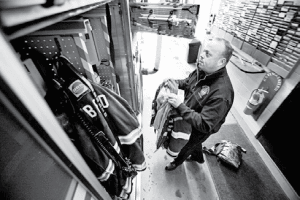
JORDAN SILVERMAN/PHOTO FOR THE TRIBUNE
"Citizens for Fire Safety did everything they could to portray themselves as firefighters, as Vermont citizens for fire safety, when it really wasn't Vermont citizens for fire safety at all." -- Matt vinci, above, president of a Vermont firefighters union, who lobbied against a flame retardant.
Both of those organizations and the federal agency, however, said that simply is not true.
"They are lying," said Jeff Zack, a spokesman for the International Association of Fire Fighters. "They aren't working with us on anything."
After inquiries from the Tribune, Citizens for Fire Safety deleted that passage from its website.
Gillham, the executive director, declined to comment. Albemarle, Chemtura and ICL Industrial Products also declined to answer specific questions about the group.
Albemarle Chief Sustainability Officer David Clary did say that his company has been transparent about its funding of Citizens for Fire Safety.
"We believe that this support for advocacy groups is critical to raise awareness of the importance of fire safety and give a voice to those who want to speak out on this important public issue," Clary said in a written statement.
Citizens for Fire Safety is the latest in a string of industry groups that have sprung up on different continents in the last 15 years — casting doubt on health concerns, shooting down restrictions and working to expand the market for flame retardants in furniture and electronics.
For example, the Bromine Science and Environmental Forum, based in Brussels, may sound like a neutral scientific body. But it was founded and funded by four chemical manufacturers, including Albemarle, to influence the debate about flame retardants made with bromine.
Albemarle's global director of product advocacy, Raymond Dawson, said in blunt testimony before Washington state lawmakers in 2007 that the forum is "a group dedicated to generating science in support of brominated flame retardants."
An official from Burson-Marsteller, the global public relations firm that helps run the organization, said the bromine group is not misleading anyone because regulators, scientists and other stakeholders are well-aware it represents industry.
The PR firm also helps run the Alliance for Consumer Fire Safety in Europe, which is funded by a trade association of flame retardant manufacturers. The alliance's director, Bob Graham, said the group's aim is to improve fire-safety standards for upholstered furniture sold in Europe.
The group's website taps into the public's fear of fire, touting an "interactive burn test tool" that allows visitors to choose a European country and watch a sofa from that nation being torched.
Next to a photo of an easy chair fully engulfed in flames, four words stand out in large capital letters: "ARE YOU SITTING COMFORTABLY?"
'IMAGINE A CHILD CRYING'
The amount of flame retardants in a typical American home isn't measured in parts per billion or parts per million. It's measured in ounces and pounds.
A large couch can have up to 2 pounds in its foam cushions. The chemicals also are inside some highchairs, diaper-changing pads and breast-feeding pillows. Recyclers turn chemically treated foam into the padding underneath carpets.
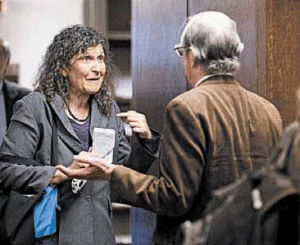
ROBERT DURELL/PHOTO FOR THE TRIBUNE
“When we’re eating organic, we’re avoiding very small amounts of pesticides. Then we sit on our couch that can contain a pound of chemicals that’s from the same family as banned pesticides like DDT.” — Arlene Blum, a California chemist who is fighting to limit flame retardants in household products. Above, she waits to testify before the California state Senate in 2011.
"When we're eating organic, we're avoiding very small amounts of pesticides," said Arlene Blum, a California chemist who has fought to limit flame retardants in household products. "Then we sit on our couch that can contain a pound of chemicals that's from the same family as banned pesticides like DDT."
These chemicals are ubiquitous not because federal rules demand it. In fact, scientists at the U.S. Consumer Product Safety Commission have determined that the flame retardants in household furniture aren't effective, and some pose unnecessary health risks.
The chemicals are widely used because of an obscure rule adopted by California regulators in 1975. Back then, a state chemist devised an easy-to-replicate burn test that didn't require manufacturers to set furniture on fire, an expensive proposition.
The test calls for exposing raw foam to a candle-like flame for 12 seconds. The cheapest way to pass the test is to add flame retardants to the foam inside cushions.
But couches aren't made of foam alone. In a real fire, the upholstery fabric, typically not treated with flame retardants, burns first, and the flames grow big enough that they overwhelm even fire-retardant foam, scientists at two federal agencies have found.
Nevertheless, in the decades since that rule went into effect, lawyers have regularly argued that their burn-victim clients would have been spared if only their sofas had been made with California foam. Faced with the specter of these lawsuits — and the logistical challenge of producing separate products just for California — many manufacturers began using flame retardant foam across their product lines.
As a result, California has become the most critical battleground in recent years for advocates trying to reduce the prevalence of these chemicals in American homes.
Citizens for Fire Safety has successfully fought back with a powerful, and surprising, tactic: making flame retardants a racial issue.
The group and witnesses with ties to it have argued that impoverished, minority children would burn to death if flame retardants were removed from household products.
In 2009, for instance, members of the California State Assembly were considering a bill that would have made it unnecessary to add flame retardants to many baby products by excluding them from the state's flammability regulation.
Up to the microphone stepped Zyra McCloud, an African-American community activist from Inglewood, Calif.
McCloud was president of a community group that listed Citizens for Fire Safety as a sponsor on its website and included photos of McCloud with Gillham, the executive director. She did not disclose this connection to the assembly, nor was she asked.
In a news release, Citizens for Fire Safety already had quoted McCloud saying that minority children, who constitute a disproportionate share of fire deaths, would bear the brunt of the "ill-conceived and unsafe legislation."
At the hearing, the committee chairwoman told both sides they were out of time for testimony, but McCloud pleaded with her to allow two elementary school students from her district to address lawmakers.
"We have spent all weekend long with the kids that have had family members and friends who have died in fires, and we are praying and appealing to you that you would at least allow the two boys to speak," she said.
One of the boys, a 10-year-old, read from a statement.
Chemicals hard to avoid
Flame retardants are present in virtually every American home even though some of the compounds have been linked to neurological deficits, developmental problems, impaired fertility and other health risks.
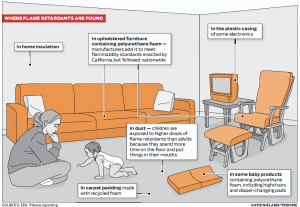
[WHERE FLAME RETARDANTS ARE FOUND: In home insulation; In upholstered furniture containing polyurethane foam -- manufacturers add it to meet flammability standards enacted by California but followed nationwide; In the plastic casing of some electronics; In dust -- children are exposed to higher doses of flame retardants than adults because they spend more time on the floor and put things in their mouths; In some baby products containing polyurethane foam, including highchairs and diaper-changing pads]
"I just want you to imagine a child crying for help in a burning building, dying, when there was a person who only had to vote to save their life," he said.
Citizens for Fire Safety prevailed. The bill later went down to defeat.
McCloud told the Tribune, "I've always been a person that's fought against things that would hurt children." She then asked for questions in writing but never answered them.
Nearly two years after that bill failed, one of the nation's top burn surgeons would also invoke the image of a dead child before California lawmakers on behalf of Citizens for Fire Safety.
'THIS IS HORRIBLE'
When Dr. David Heimbach walked into the California Senate committee hearing last year, the stakes had never been higher for flame retardant manufacturers.
Once again, senators were considering an overhaul of the state's flammability regulation — one that advocates believed would dramatically reduce the amount of flame retardants in American homes.

ROBERT DURELL/PHOTO FOR THE TRIBUNE
“I’m a well-meaning guy. I’m not in the pocket of industry.”
— Dr. David Heimbach, a burn expert. Above, Heimbach testifies in 2011 against a California state Senate bill that could have reduced the use of flame retardant chemicals in furniture. He told the Tribune that Citizens for Fire Safety has paid for his travel to testify and for some of his time.
The bill would allow manufacturers to choose the existing candle-like flame test or a new one based on a smoldering cigarette, a far more common source of fires than candles. Manufacturers could pass the new test by using resistant fabrics rather than adding toxic chemicals to the foam inside.
To maintain the status quo — and avoid a hit to the bottom line — chemical makers needed to stress that fires started by candles were a serious threat.
Heimbach, Citizens for Fire Safety's star witness, did just that.
With Citizens for Fire Safety's Gillham watching from the audience, Heimbach not only passionately described the fatal burns a 7-week-old Alaska patient received lying on a pillow that lacked flame retardants, he also blamed the 2010 blaze on a candle.
In fact, he specifically said the baby's mother had placed a candle in the girl's crib.
Heimbach had told similar stories before, the Tribune found. In 2009, he told a California State Assembly committee that he had treated a 9-week-old girl who died that spring after a candle beside her crib turned over. "We had to split open her fingers because they were so charred," he testified.
In 2010, he told Alaska lawmakers about a 6-week-old girl from Washington state who died that year after a dog knocked a candle onto her crib, which did not have a flame retardant mattress.
Heimbach's hospital in Seattle, Harborview Medical Center, declined to help the Tribune confirm his accounts. But records from the King County medical examiner's office show that no child matching Heimbach's descriptions has died in his hospital in the last 16 years.
The only infant who came close in terms of age and date of death was Nancy Garcia-Diaz, a 6-week-old who died in 2009 after a house fire in rural Washington.
In an interview, Heimbach said his anecdotes were all about the same baby — one who died at his hospital, though he didn't know the child's name. Contrary to his testimony, he said he had not taken care of the patient.
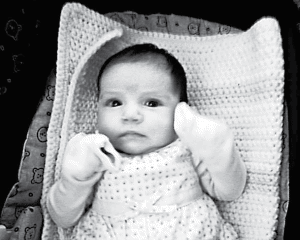
PHOTO PROVIDED BY FAMILY
“Nancy’s memory is sacred to us. My daughter deserves respect. She lived such a short time and she suffered a lot. This is horrible.” — Mother of Nancy Garcia-Diaz, above, a 6-week-old girl who died in 2009 after a house fire in rural Washington.
Told about Nancy, Heimbach said she was probably the baby he had in mind and emailed a Tribune reporter two photographs of a severely burned child, images that he said he had used in a presentation at a medical conference. Medical records and Nancy's mother confirmed those pictures were indeed of Nancy.
But Nancy didn't die in a fire caused by a candle, as Heimbach has repeatedly testified. Fire records obtained by the Tribune show the blaze was caused by an overloaded, overheated extension cord.
"There were no candles, no pets — just the misuse of extension cords," said Mike Makela, an investigator for the Snohomish County fire marshal's office.
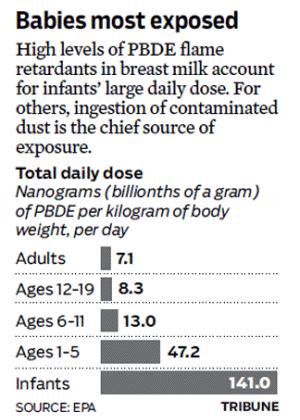
Babies most exposed. High levels of PBDE flame retardants in breast milk account for infants’ large daily dose. For others, ingestion of contaminated dust is the chief source of exposure.
In his testimony last year, Heimbach stated the baby was in a crib on a fire-retardant mattress and on a non-retardant pillow. The upper half of her body was burned, he said.
But public records show there was no crib — she was resting on a bed — and no pillow. And, Makela said, flame retardants played no role in the pattern of her burns.
Fire authorities, Heimbach said, "may know more about it than I do, but that was the information that I had."
Heimbach said he couldn't recall who gave him that information but that Citizens for Fire Safety did not help craft his statements. He said the group has paid for his travel to testify and for some of his time, though he would not give a dollar amount.
The details of his statements, he said, weren't as important as the principle. "The principle is that fire retardants will retard fires and will prevent burns," he said.
Later, Heimbach said through his attorney that federal rules prohibit him from disclosing information that would identify a patient. He said that when describing particular burn cases, he follows standard protocol under the rules by "de-identifying" patients — that is, changing or omitting identifying information to protect their privacy.
But in testimony at state hearings, Heimbach not only changed facts, he added new ones, such as candles starting deadly blazes and the lack of flame retardants — details that aided the chemical industry's position.
Nancy's mother, who asked that her name not be used, said she never granted Heimbach permission to use her daughter's photograph.
"Nancy's memory is sacred to us," she said. "My daughter deserves respect. She lived such a short time and she suffered a lot. This is horrible."
Heimbach was head of Harborview's burn center for 25 years; he also was a professor of surgery at the University of Washington until his retirement last year. He estimated he might have saved "hundreds if not thousands" of lives. In 2009, the Dalai Lama presented Heimbach an award for his pioneering care of burn victims around the world.
"I'm a well-meaning guy," Heimbach said. "I'm not in the pocket of industry."
When Heimbach testified last spring in California on the bill that could have significantly reduced the use of flame retardants, he didn't tell lawmakers he was altering facts about the burn victim. Only when asked by a senator did he reveal that Citizens for Fire Safety paid for his trip there.
When it came time to vote, the senators overwhelmingly sided with Heimbach and Citizens for Fire Safety, sticking with the furniture standard based on a candle-like flame.
Public health advocates had one last hope: Senators had seven days in which they could change their votes. As the advocates tried to persuade senators to reconsider, Citizens for Fire Safety put out a news alert that linked to a video called "Killer Couches!"
To the sounds of sinister music and crackling flames, a sofa made without flame retardants became an inferno. Then these words appeared: "Are You Sitting Comfortably?"
No senators changed their votes, and the bill was dead. The chemical companies had won again.
Types of flame retardants
Many flame retardants are made with bromine or chlorine, which slow fire’s combustive reaction by taking the place of oxygen. However, tests have cast doubt on whether adding the chemicals to upholstered furniture is effective, and concerns over health risks have forced some products off the market.
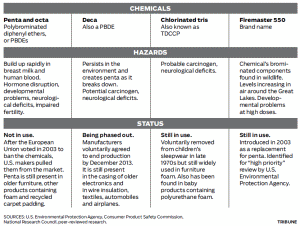
Tribune reporter Michael Hawthorne contributed to this report.
[email protected]
[email protected]
Copyright © 2015, Chicago Tribune
